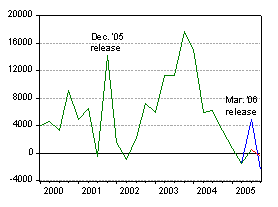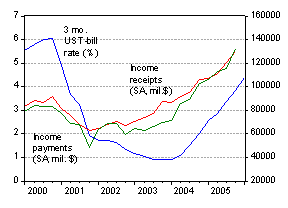Mixed news for 4th quarter net income in the current account release
A month ago, I made a prediction regarding the trajectory of the net income flow in the current account balance. This issue is relevant given the discussion about the Hausmann-Sturzenegger “dark matter” hypothesis. I indicated that -$502 million entry for 2005q4 would be a plausible outcome, reflecting rising interest rates combined with increasing foreign holdings of US debt securities.
As it turned out, the March 2006 balance of payments release only partly confirmed my views. The actual net income deficit was worse than predicted; net income was -$2.4 billion, rather than -$0.5 billion predicted (on a seasonally adjusted basis). On the other hand, the 2005q3 net income was revised upward from +$0.5 billion to +$2.9 billion.

Net income (SA, millions $), from December ’05 and March ’06 releases, and prediction based on December ’05 release. Source: BEA, and author’s calculations.
(Green line: December ’05 release; Blue line: March ’06 release; Red line: prediction based on December ’05 release). Nonetheless, the main point of that post — namely that the trajectory of the net income account was likely to be negative — remains intact, largely because the US interest rate has continued to rise in the first quarter of 2006.

US 3 month T-bill rate in secondary market (left scale), income receipts and payments (right scale). Source: BEA, and St. Louis Fed FRED II.
Now it is true that foreign rates (especially those in Europe) move with U.S. rates (see this paper); but to the extent that our payments are much more related to returns on debt securities than our receipts, higher interest rates are likely to lead to a widening net income deficit.
Technorati Tags: balance of payments,
dark matter,
net income,
interest rates
It looks to me that this one is going negative and will stay that way. Anyone disagree? Once that happens, the “dark matter” story will disappear rather quickly. My own forecast is that it will take this getting to at least $-100 billion before people really start to pay attention and get seriously worried.
I agree. I think we’ll find that dark matter is a two way street. I think we’ll hit -$100B in short time. The interest on our deficit from last year alone should add about -$40B this year and that assumes interest rates stay constant.
I found the referenced paper on the Eruo and a world interest rate very informative.
I would like to see you discuss the entire subject within the context that the Greedspan conundrum is a demonstration that as we become more and more dependent on foreign capital we are losing the ability to conduct an independent monetary policy. US bond yieleds now seem to be driven more by world financial conditions then fed policy.
Spencer: I think it is a natural implication of increasing foreign holdings of US Treasuries that the long end of the spectrum will be less influenced by domestic factors (including the Fed Funds rate), even as the Fed will continue to determine fully the short rate.
If foreign investors become satiated, then it may be that domestic factors come to the fore again. All this is speculation, as we don’t have many independent observation points to make a formal judgment about the strength of the foreign effect, and its durability. In addition, the main theoretical implication of international finance — namely the relationship between an exchange risk premium and the stock of dollar denominated assets relative to the stock of all assets — remains one of the most elusive empirical relations.
Thanks for the reply.
I think we are more likely to get the answer when domestic considerations call for lower rates and foreign influences prevent it.
http://www.simurl.com/wifwol
How does United Airlines figure into dark matter?